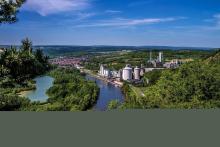
Depending on the application, EcoCrete offers between 30 and 66% CO₂ reduction per m³ of concrete compared to the reference value of the industry. This reduction is achieved on a strictly technical basis and without compensation measures. In addition, EcoCrete is available in particularly resource-saving types with at least 10% of recycled content. Also, part of the EcoCrete concept is the 100% use of green electricity, the use of recycled water, and the complete recyclability of the concrete in the case of subsequent deconstruction.
"Expanding local, sustainable product portfolios is a key element of HeidelbergCement's climate strategy," said Dr. Dominik von Achten, chairman of the managing board of HeidelbergCement. "The launch of EcoCrete in the German market is representative of the ambitious CO₂ roadmaps we are implementing at all levels of the company and in all Group countries".
Dr. Nicola Kimm, chief sustainability officer and member of the managing board of HeidelbergCement, said: "We are committed to regionally produced, CO₂-optimised building materials that push the limits of what is technically feasible today in terms of sustainability. Our cements and concretes are also being continuously developed to reduce the ecological footprint even further in the future – over the entire life cycle."
A significant part of HeidelbergCement's research and development activities focuses on minimising energy use and CO₂ emissions through innovative products and process improvements. The company has set itself the goal of reducing its CO₂ emissions by 30% by 2025 compared with the reference year 1990 and achieving climate neutrality by 2050 at the latest.
HeidelbergCement is a global leader in the building materials industry in the development and application of innovative technologies for carbon capture and utilisation. With its increasing involvement in concrete recycling, the company also contributes to the circular economy.










